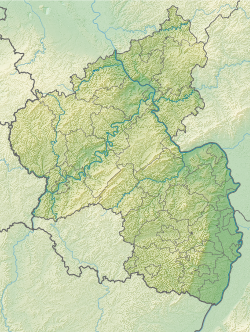| UNESCO World Heritage Site | |
|---|---|
 | |
| Location | Trier, Rhineland-Palatinate, Germany |
| Part of | Roman Monuments, Cathedral of St Peter and Church of Our Lady in Trier |
| Criteria | Cultural: (i), (iii), (iv), (vi) |
| Reference | 367-001 |
| Inscription | 1986 (10th Session) |
| Coordinates | 49°44′53″N 6°38′57″E / 49.748086°N 6.649054°E |

The Trier Amphitheater is a Roman amphitheater in Trier, Germany. It is designated as part of the Roman Monuments, Cathedral of St. Peter and Church of Our Lady in Trier UNESCO World Heritage Site as a testimony to the importance of Trier as a major Roman city north of the Alps.[1]
YouTube Encyclopedic
-
1/3Views:1 1761 0583 426
-
Tour of Roman Amphitheater in Trier Germany
-
Das Amphitheater von Trier
-
Der Gladiator Valerius - Erlebnisführung in Trier
Transcription
History
Trier and its amphitheatre resembled many Roman cities of its time in that many infamous gladiatorial contests occurred there. The structure which was dug into the side of a hill was erected around the 2nd century A.D during the rule of Antoninus Pius. Measuring 120 by 145 meters, the amphitheatre could accommodate approximately 20,000 spectators[2] and is the 10th largest Roman amphitheatre still intact.[3] It was built into what was at the time the city's wall, to the east of the modern and Roman city centre.[4][5] When Constantius Chlorus moved to Trier, Germany around 293 during the Tetrarchy he renovated the amphitheater.[6]
Usage
The multiple usages of the arena included gladiator events and animal shows in which a cellar under the arena was utilized to store the animals and sentence prisoners to death.[3] Remnants of wood and 1200 coins from the late 3rd century onward have been found in the cellar, suggesting that the cellar and other subterranean galleries were built after the original amphitheatre.[5] On the eastern bank of the amphitheatre, a small burial ground was discovered in 1996, containing the graves of 46 people.[5] Today, the amphitheatre is used for simulated gladiator fights and performances.[5]
Gallery
See also

References
- ^ "Roman Monuments, Cathedral of St Peter and Church of Our Lady in Trier". UNESCO World Heritage Centre. United Nations Educational, Scientific, and Cultural Organization. Retrieved 22 May 2022.
- ^ "Amphitheatre | , Germany | Sights".
- ^ a b "Tourist-Information Trier". www.trier-info.de. Retrieved 22 May 2022.
- ^ "Roman Amphitheater- Trier, Germany - Outdoor Amphitheaters on Waymarking.com". www.waymarking.com. Retrieved 2018-04-05.
- ^ a b c d Hans-Peter Kuhnen (2009). Wilmott, Tony (ed.). Roman amphitheatres and Spectacula, a 21st -century perspective : papers from an international conference held at Chester, 16th-18th February, 2007. Oxford: Archaeopress. pp. 95–104. ISBN 9781407304267.
- ^ "Trier, Amphitheater - Livius". www.livius.org. Retrieved 2018-04-05.
External links
- "Tourist-Information Trier: Amphitheater: Info". trier-info.de. Retrieved 2014-01-31.






